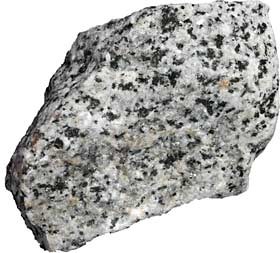
Where do granite and granodiorite form? Granite and granodiorite are intrusive igneous rocks that slowly cool deep underground in magma chambers called plutons. This slow cooling process allows easily visible crystals to form. Both rocks are the product of the melting of continental rocks near subduction zones.
What is the difference between granite and granodiorite? These rocks are both classified as granitic, because they both are rich in quartz. Granite contains mostly potassium feldspars and has a low percentage of dark iron and magnesium minerals. In contrast, granodiorite contains more plagioclase (calcium and sodium) feldspar than potassium feldspar and has more dark minerals. Thus it is a darker color than granite. Chemical and x-ray analysis of granite and granodiorite can be used to “fingerprint” these rocks, telling their exact composition and where they may have formed.
Where do you find granite and granodiorite? Granitic rocks are found on continents around the world near active or past plate boundaries. They formed as magma cooled many kilometers below the Earth’s surface. The granitic rocks were then uplifted to the surface as the volcanic mountains above them eroded away. In California, granitic rocks form the core of the Sierra Nevada, cooled from rock melted during the subduction process that also formed the rocks of the Franciscan Complex. Granite and granodiorite are also found west of the San Andreas fault near Monterey, Pacifica, and Point Reyes, where granite from the south end of the Sierra range has been transported northward by San Andreas fault movement. Some granite was also carried to the California coast from China by humans. Chinese granite sometimes filled the holds of sailing ships on their way to San Francisco during the Gold Rush.
Why do some grantitic rocks have both large and small crystals in them? This type for rock is called a porphyry. The different crystal sizes are the result of different rates of cooling as the magma body moved upwards. The large crystals, called phenocrysts, are usually feldspar crystals. Feldspar is one of the first minerals to form large crystals as magma solidifies. They grew as the magma cooled very slowly deep in the magma chamber. Later, the magma with the phenocrysts moved quickly upward into cooler rock, causing more rapid cooling of the remaining molten rock to form the smaller crystals that make up the rest of the rock. 
|
Last updated: February 28, 2015
